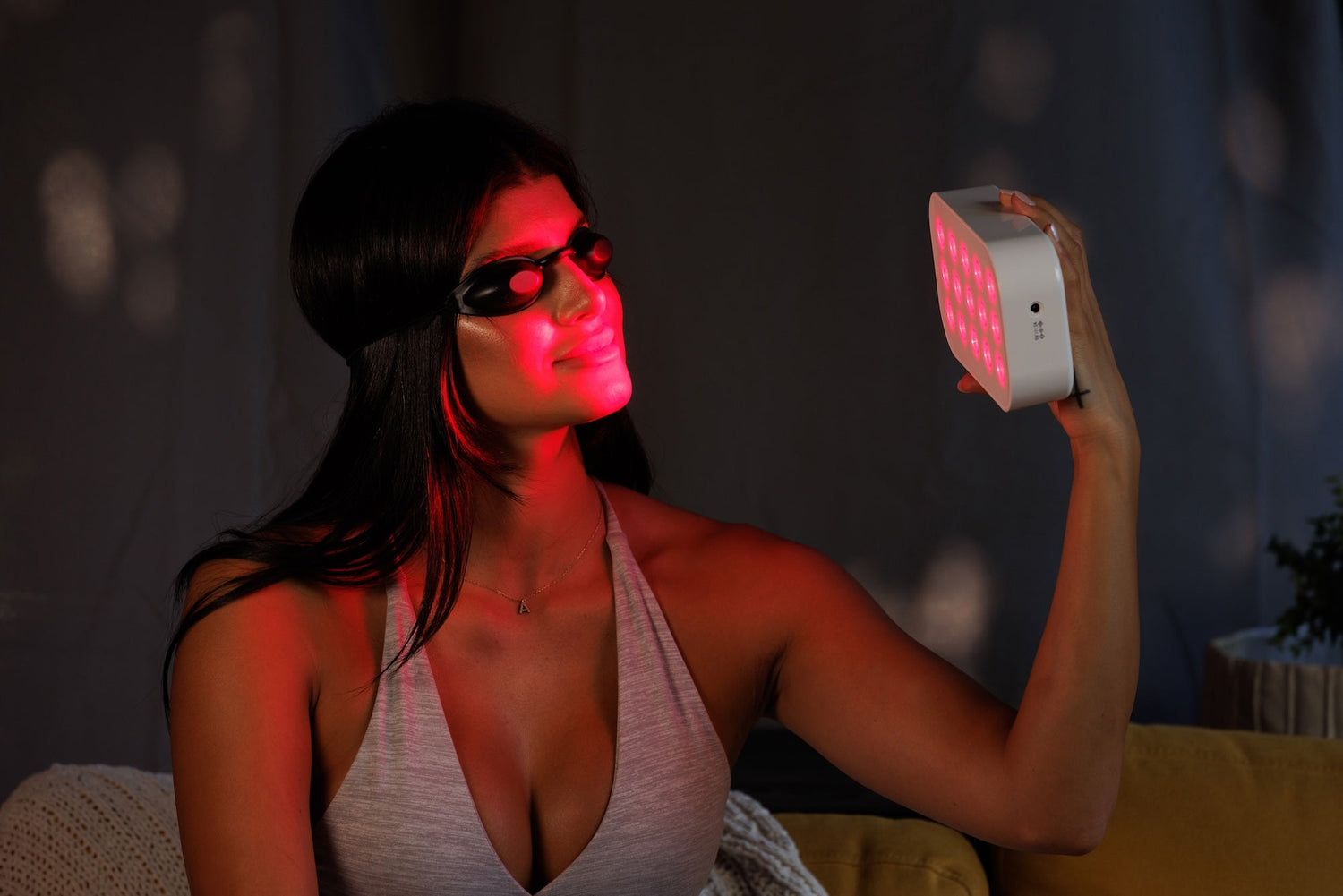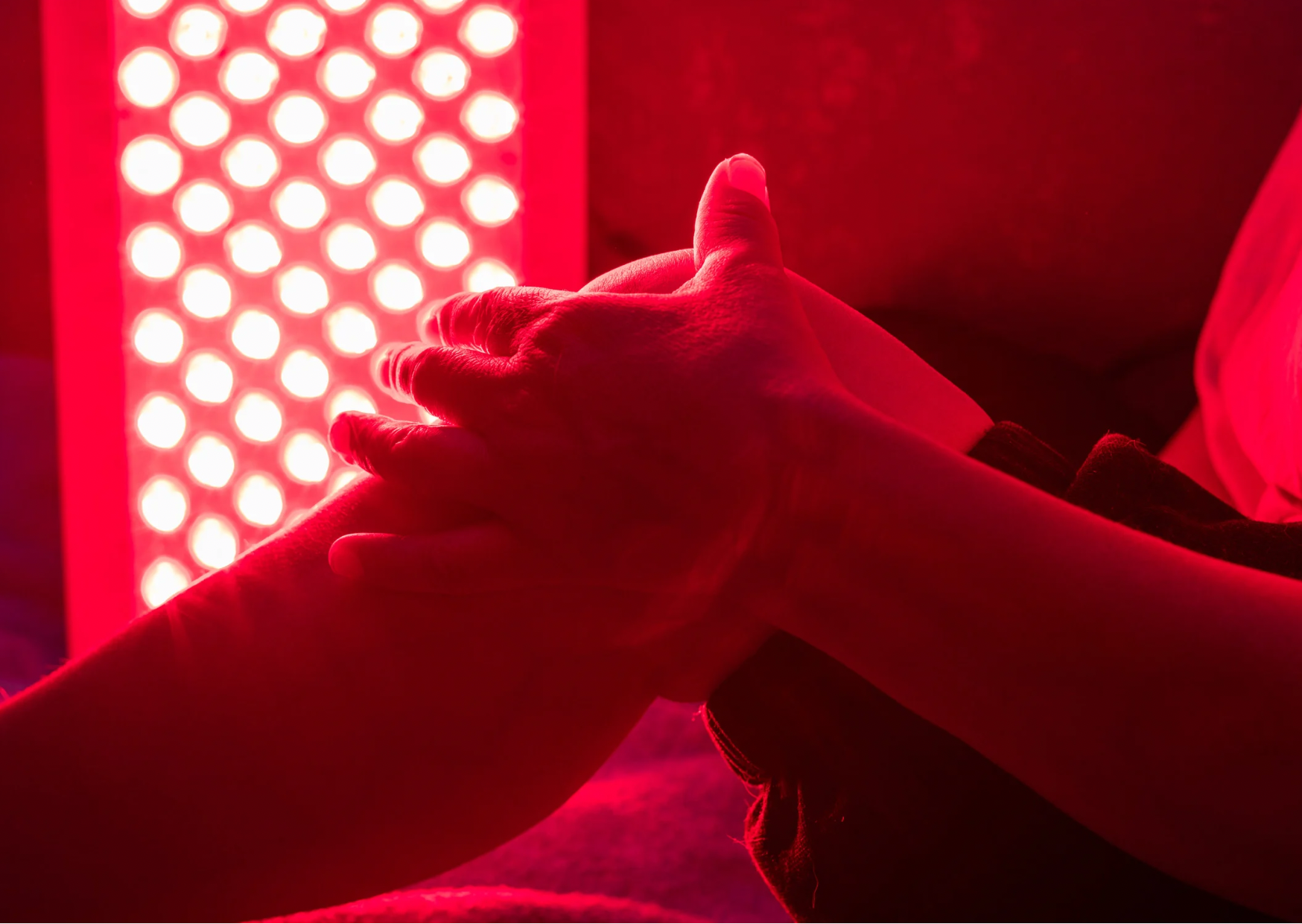The advantages of red light therapy are far from being a recent discovery.
Exposure to natural light, especially through the eyes, plays a vital role in regulating circadian rhythms, improving sleep and hormone cycles, bolstering the immune system, reducing stress, supporting mental health, and providing essential vitamin D. Light is so important that there is only one area of the body that it can’t penetrate - the spleen. Instead, neurons direct light that lands on the eyes and skin straight to this vital organ. Clearly, receiving light through the eyes is essential for human health.
Natural light and red light go hand in hand.
Natural light is essential for overall health, mood regulation, and sleep quality. Red light therapy offers targeted benefits, particularly for skin health, pain management, and certain medical conditions. Due to the penetrating effect of red light therapy (RLT), no other wavelength or sense can induce the same targeted benefits that red light provides for the body. However, this natural and effective therapy is only safe at specific wavelengths and intensities, for a short amount of time.
For regular LUMEBOX users out there, particularly those who incorporate this therapy around the face and neck areas, concerns have arisen about potential eye-related hazards from red or near-infrared (NIR) light. In this article, we dissect the existing research to help you safely use RLT in terms of:
- Wavelength
- Irradiance
- Time
- LEDs vs Laser
- Distance from eyes
- Precautionary steps
What are the current guidelines for RLT use around eyes?
According to the American Academy of Ophthalmology, there is some evidence that light therapy has the potential to improve eye health. However, more data is needed before it can be used to treat ocular diseases or aging eyes.
Some scientists think red light recharges the cell’s powerhouse or “battery,” known as the mitochondria. As we age, mitochondria produce less energy. Deep red light may restore energy production to youthful levels [20]
Before red light can be considered as a possible treatment for eye conditions, it must be tested in human clinical trials to make sure it is safe and to determine the most effective wavelength, dose, duration of treatment and delivery method.
If the findings hold up in humans, red light therapy may someday hold promise for treating age-related conditions such as macular degeneration, diabetic eye disease or loss of color vision.
What is considered a safe limit?
As per the International Commission for Non-Ionizing Radiation Protection (IEC 62471) standard, the eye can only be exposed to 10mW/cm2 of IR LED for less than 16 minutes 42 seconds to avoid thermal damage. The standard recommends a safe limit of only 57 mW/cm2 for less than 1 minute 40 seconds. The ANSI/IESNA and CIE/IEC lamp safety standards state that the maximum measured irradiance at a standard viewing distance of 20cm for infrared is 1mW/cm2.
If you use the LUMEBOX on your face or your eyes are in the beam window of the device, goggles are advised because LUMEBOX is powerful, with a high irradiance.
Hang on, but I thought red light therapy was GOOD for eyes?
Preliminary studies suggest benefits in using extremely low-powered red light for conditions like photoaging [10], glaucoma [6], and myopia [11,12,14,13].
This is the study that got the internet talking:
Dr Glen Jeffery from the UCL Institute of Ophthalmology found that for adults aged 40 or over, there was a 17% improvement in color contrast vision when exposed to 670 nm light at 8mW/cm2 for 3 minutes at a time, just 1-3 times per week [10]. This wavelength was found to be effective in reducing inflammation, a common feature of aging [17], by increasing the expression of a certain mitochondrial enzyme.
Further, the greatest effects were seen when participants received exposure early in the morning, as opposed to the evening.
In his research, Dr. Jeffery also found that inflammation can be reduced when red light is delivered indirectly as a part of environmental lighting [17]. In a similar study, red light (670nm) was delivered through LEDs at an irradiance of 20mW/cm2 (The irradiance of Lumebox’s red light is over 6x more powerful than this). Subjects received light in the form of supplemented environmental light rather than a direct source, and for a maximum of 6 minutes at a time.
The lights used in these studies are much lower powered light (at a fraction of the power and irradiance of LUMEBOX) and used only for very short time periods (1-3 minutes). We don’t know if higher power and irradiance is safe yet, or how long you can safely use it for.
What are the dangers of red light via LEDs and Laser?
Dose makes the poison - Too much exposure to red light or NIR can have damaging thermal effects on the tissues in the eye, this is especially the case for NIR.
Although NIR is considered non-ionizing radiation, it can have thermal effects on living tissues. Excessive exposure to infrared radiation can lead to eye damage, including retinal burns and cataractogenesis. [1] These are less likely with light delivered by LED [3] making it safer for eyes when compared to laser.
The extent of these effects also depends on factors like the energy, power density, duration of exposure, and tissue characteristics. The eye's lens and retina have different absorption properties for infrared radiation, and temperature rises in the eye can contribute to damage too [2], and why NIR should be treated with more caution when it comes to eyes.
Summary
In most scientific studies on eye health, red light is delivered in low doses whether by reducing irradiance, exposure duration, or increasing distance.
Note: Always consult with your doctor, but generally speaking, if you're using red light and NIR on body areas away from the face and neck, and your eyes are not in the beam window of the device, goggles may not be necessary. However, we recommend that goggles be worn until more scientific consensus is reached on the optimal dose of light for eyes.
Current LUMEBOX Recommendation:
Eye protection should always be used when operating the device. Do not stare directly at the LEDs. If your eyes are sensitive to light or if you take medications that cause photosensitivity, consult a medical professional prior to use.
New to red light therapy? Download our free eBook to help you choose the best device.
Already have a LUMEBOX? Download our 6 time-saving tricks guide!
Medical Disclaimer: The information contained in this blog post is intended for educational purposes only and should not be used as medical advice. Everyone responds to light differently. Testimonials are not a guarantee of the results you or anyone who uses LUMEBOX will get because your success depends entirely on your circumstances, and the studies on red light therapy shared were not specifically performed using LUMEBOX. Please check with your doctor before using red light therapy and do not change your medical treatments or lifestyle without consulting your physician first.
Citations:
[1] Kourkoumelis, N. and Tzaphlidou, M. (2011) Eye safety related to near infrared radiation exposure to biometric devices. TheScientificWorldJOURNAL 11, 520–528. DOI 10.1100/tsw.2011.52.
[2] Kourkoumelis, N., & Tzaphlidou, M. (2010). Eye Safety Related to Near Infrared Radiation Exposure to Biometric Devices.
https://www.ncbi.nlm.nih.gov/pmc/articles/PMC5720004/pdf/TSWJ-2011-11-902610.pdf [8] Xiong, R., Zhu, Z., Jiang, Y., Kong, X., Zhang, J., Wang, W., Kiburg, K., Yuan, Y., Chen, Y., Zhang, S., Xuan, M., Zeng, J., Morgan, I. G., & He, M. (2022). Sustained and rebound effect of repeated low-level red-light therapy on myopia control: A 2-year post-trial follow-up study. Clinical & experimental ophthalmology, 50(9), 1013–1024. https://doi.org/10.1111/ceo.14149 [3] Okuyama, S., Nagaya, T., Ogata, F., Maruoka, Y., Sato, K., Nakamura, Y., Choyke, P. L., & Kobayashi, H. (2017). Avoiding thermal injury during near-infrared photoimmunotherapy (NIR-PIT): the importance of NIR light power density. Oncotarget, 8(68), 113194–113201. https://doi.org/10.18632/oncotarget.20179
[4] Xiong, R., Zhu, Z., Jiang, Y., Kong, X., Zhang, J., Wang, W., Kiburg, K., Yuan, Y., Chen, Y., Zhang, S., Xuan, M., Zeng, J., Morgan, I. G., & He, M. (2022). Sustained and rebound effect of repeated low-level red-light therapy on myopia control: A 2-year post-trial follow-up study. Clinical & experimental ophthalmology, 50(9), 1013–1024. https://doi.org/10.1111/ceo.14149
[5] Kourkoumelis, N. and Tzaphlidou, M. (2011) Eye safety related to near infrared radiation exposure to biometric devices. TheScientificWorldJOURNAL 11, 520–528. DOI 10.1100/tsw.2011.52.
[6] Bergandi L, Silvagno F, Grisolia G, Ponzetto A, Rapetti E, Astori M, Vercesi A, Lucia U. The Potential of Visible and Far-Red to Near-Infrared Light in Glaucoma Neuroprotection. Applied Sciences. 2021; 11(13):5872. https://doi.org/10.3390/app11135872
[7] http://wiki.cogain.info/images/c/c8/COGAIN-D5.4.pdf
[8] International Commission of Non-Ionizing Radiation Protection (ICNIRP)
[9] Mohiuddin, T. M., Zhang, C., Sheng, W., Al-Rawe, M., Zeppernick, F., Meinhold-Heerlein, I., & Hussain, A. F. (2023). Near Infrared Photoimmunotherapy: A Review of Recent Progress and Their Target Molecules for Cancer Therapy. International journal of molecular sciences, 24(3), 2655. https://doi.org/10.3390/ijms24032655
[10] Shinhmar, H., Hogg, C., Neveu, M. et al. Weeklong improved colour contrasts sensitivity after single 670 nm exposures associated with enhanced mitochondrial function. Sci Rep 11, 22872 (2021). https://doi.org/10.1038/s41598-021-02311-1
[11] Xu, X. and He, M., Effect of Repeated Low-Level Red-Light on Myopia Prevention in Premyopic Children. Shanghai Eye Disease Prevention and Treatment Center, Shanghai, China. (2021)
[12] Chen, H., Wang, W., Liao, Y. et al. Low-intensity red-light therapy in slowing myopic progression and the rebound effect after its cessation in Chinese children: a randomized controlled trial. Graefes Arch Clin Exp Ophthalmol 261, 575–584 (2023). https://doi.org/10.1007/s00417-022-05794-4
[13] Jiang, Y., Zhu, Z., Tan, X., Kong, X., Zhong, H., Zhang, J., Xiong, R., Yuan, Y., Zeng, J., Morgan, I. G., & He, M. (2022). Effect of Repeated Low-Level Red-Light Therapy for Myopia Control in Children: A Multicenter Randomized Controlled Trial. Ophthalmology, 129(5), 509–519. https://doi.org/10.1016/j.ophtha.2021.11.023
[14] Xiong, R., Zhu, Z., Jiang, Y., Wang, W., Zhang, J., Chen, Y., Bulloch, G., Yuan, Y., Zhang, S., Xuan, M., Zeng, J., & He, M. (2023). Longitudinal Changes and Predictive Value of Choroidal Thickness for Myopia Control after Repeated Low-Level Red-Light Therapy. Ophthalmology, 130(3), 286–296. https://doi.org/10.1016/j.ophtha.2022.10.002
[15] Clark, E.T.; Scott, D.; Scott, B. Devices and Methods for Non-Invasive Multi-Wavelength Photobiomodulation for Ocular Treatments. U.S. Patent 10596037-B2, 24 March 2020.
[16] Ivandic, B. T., & Ivandic, T. (2012). Low-level laser therapy improves visual acuity in adolescent and adult patients with amblyopia. Photomedicine and laser surgery, 30(3), 167–171. https://doi.org/10.1089/pho.2011.3089
[17] Begum R, Powner MB, Hudson N, Hogg C, Jeffery G (2013) Treatment with 670 nm Light Up Regulates Cytochrome C Oxidase Expression and Reduces Inflammation in an Age-Related Macular Degeneration Model. PLOS ONE 8(2): e57828. https://doi.org/10.1371/journal.pone.0057828
[18] Tanaka, Y., & Nakayama, J. (2016). Upregulated epidermal growth factor receptor expression following near-infrared irradiation simulating solar radiation in a three-dimensional reconstructed human corneal epithelial tissue culture model. Clinical interventions in aging, 11, 1027–1033. https://doi.org/10.2147/CIA.S111530
[19] https://www.hubermanlab.com/episode/using-light-sunlight-blue-light-and-red-light-to-optimize-health
[20] Geneva II. Photobiomodulation for the treatment of retinal diseases: a review. Int J Ophthalmol. 2016 Jan 18;9(1):145-52. doi: 10.18240/ijo.2016.01.24. PMID: 26949625; PMCID: PMC4768515.




